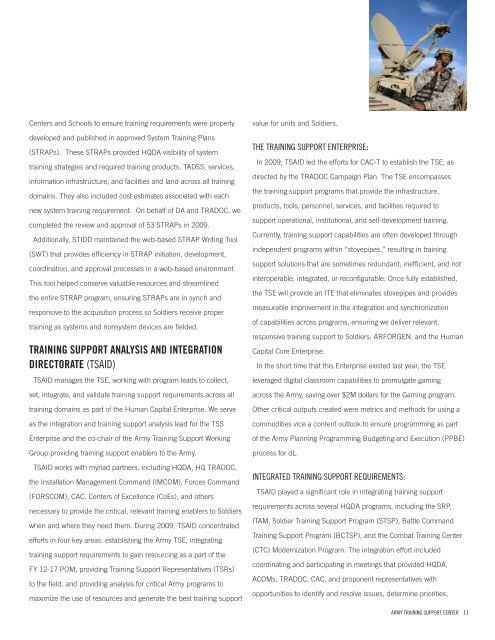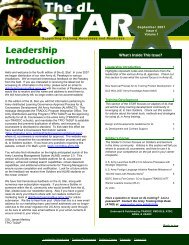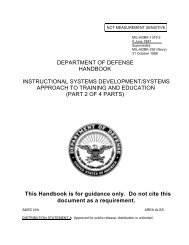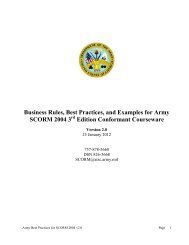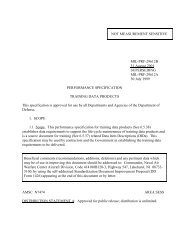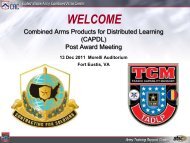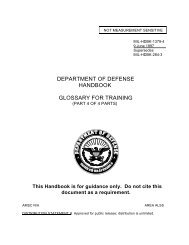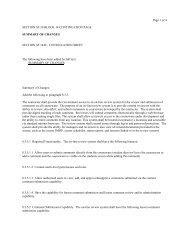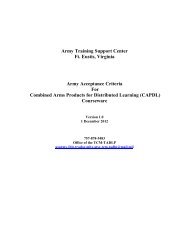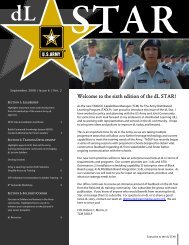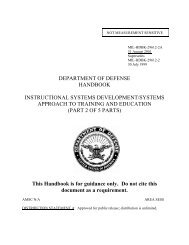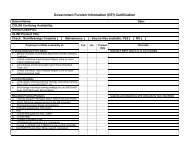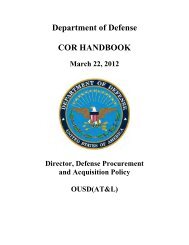annual report 2008 annual report 2009 - U. S. Army Training ...
annual report 2008 annual report 2009 - U. S. Army Training ...
annual report 2008 annual report 2009 - U. S. Army Training ...
You also want an ePaper? Increase the reach of your titles
YUMPU automatically turns print PDFs into web optimized ePapers that Google loves.
Centers and Schools to ensure training requirements were properly<br />
developed and published in approved System <strong>Training</strong> Plans<br />
(STRAPs). These STRAPs provided HQDA visibility of system<br />
training strategies and required training products, TADSS, services,<br />
information infrastructure, and facilities and land across all training<br />
domains. They also included cost estimates associated with each<br />
new system training requirement. On behalf of DA and TRADOC, we<br />
completed the review and approval of 53 STRAPs in <strong>2009</strong>.<br />
Additionally, STIDD maintained the web-based STRAP Writing Tool<br />
(SWT) that provides efficiency in STRAP initiation, development,<br />
coordination, and approval processes in a web-based environment.<br />
This tool helped conserve valuable resources and streamlined<br />
the entire STRAP program, ensuring STRAPs are in synch and<br />
responsive to the acquisition process so Soldiers receive proper<br />
training as systems and nonsystem devices are fielded.<br />
TRAINING SUPPORT ANALYSIS AND INTEGRATION<br />
DIRECTORATE (TSAID)<br />
TSAID manages the TSE, working with program leads to collect,<br />
vet, integrate, and validate training support requirements across all<br />
training domains as part of the Human Capital Enterprise. We serve<br />
as the integration and training support analysis lead for the TSS<br />
Enterprise and the co-chair of the <strong>Army</strong> <strong>Training</strong> Support Working<br />
Group providing training support enablers to the <strong>Army</strong>.<br />
TSAID works with myriad partners, including HQDA, HQ TRADOC,<br />
the Installation Management Command (IMCOM), Forces Command<br />
(FORSCOM), CAC, Centers of Excellence (CoEs), and others<br />
necessary to provide the critical, relevant training enablers to Soldiers<br />
when and where they need them. During <strong>2009</strong>, TSAID concentrated<br />
efforts in four key areas: establishing the <strong>Army</strong> TSE, integrating<br />
training support requirements to gain resourcing as a part of the<br />
FY 12-17 POM, providing <strong>Training</strong> Support Representatives (TSRs)<br />
to the field, and providing analysis for critical <strong>Army</strong> programs to<br />
maximize the use of resources and generate the best training support<br />
value for units and Soldiers.<br />
THE TRAINING SUPPORT ENTERPRISE:<br />
In <strong>2009</strong>, TSAID led the efforts for CAC-T to establish the TSE, as<br />
directed by the TRADOC Campaign Plan. The TSE encompasses<br />
the training support programs that provide the infrastructure,<br />
products, tools, personnel, services, and facilities required to<br />
support operational, institutional, and self-development training.<br />
Currently, training support capabilities are often developed through<br />
independent programs within “stovepipes,” resulting in training<br />
support solutions that are sometimes redundant, inefficient, and not<br />
interoperable, integrated, or reconfigurable. Once fully established,<br />
the TSE will provide an ITE that eliminates stovepipes and provides<br />
measurable improvement in the integration and synchronization<br />
of capabilities across programs, ensuring we deliver relevant,<br />
responsive training support to Soldiers, ARFORGEN, and the Human<br />
Capital Core Enterprise.<br />
In the short time that this Enterprise existed last year, the TSE<br />
leveraged digital classroom capabilities to promulgate gaming<br />
across the <strong>Army</strong>, saving over $2M dollars for the Gaming program.<br />
Other critical outputs created were metrics and methods for using a<br />
commodities vice a content outlook to ensure programming as part<br />
of the <strong>Army</strong> Planning Programming Budgeting and Execution (PPBE)<br />
process for dL.<br />
INTEGRATED TRAINING SUPPORT REQUIREMENTS:<br />
TSAID played a significant role in integrating training support<br />
requirements across several HQDA programs, including the SRP,<br />
ITAM, Soldier <strong>Training</strong> Support Program (STSP), Battle Command<br />
<strong>Training</strong> Support Program (BCTSP), and the Combat <strong>Training</strong> Center<br />
(CTC) Modernization Program. The integration effort included<br />
coordinating and participating in meetings that provided HQDA,<br />
ACOMs, TRADOC, CAC, and proponent representatives with<br />
opportunities to identify and resolve issues, determine priorities,<br />
ARMY TRAINING SUPPORT CENTER 11


